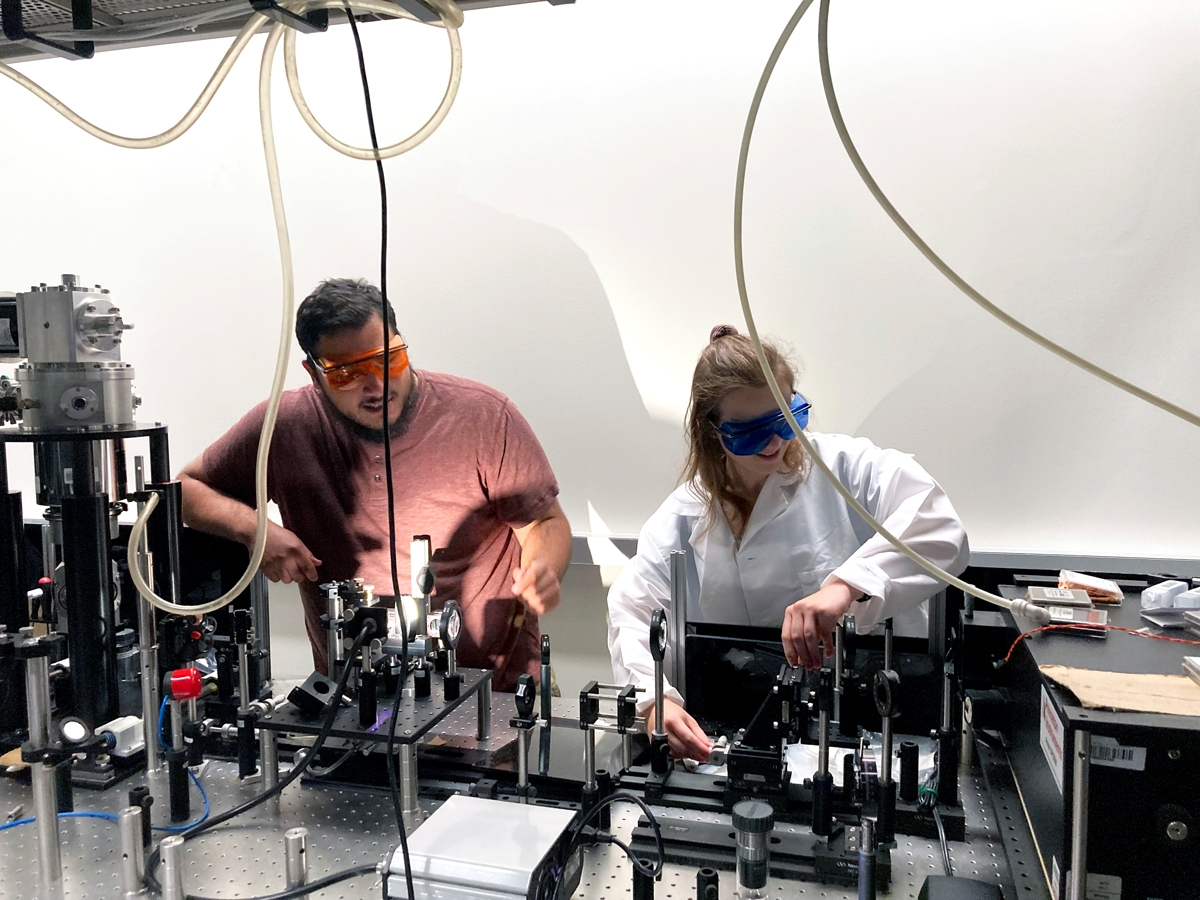Reviewed by Alex SmithMay 4 2022
Scientists from the University of Oklahoma, the National Renewable Energy Laboratory, the University of North Texas, the NASA Glenn Research Center, and several other collaborators of the space power community, have recently identified the optimal conditions for assessing perovskite solar cells for space.
 University of Oklahoma graduate student, Sergio Chacon, helping undergraduate researcher Rachel Penner set up perovskite solar cell measurements. Image Credit: University of Oklahoma.
University of Oklahoma graduate student, Sergio Chacon, helping undergraduate researcher Rachel Penner set up perovskite solar cell measurements. Image Credit: University of Oklahoma.
The study was published in the journal Joule.
Perovskites are a type of material that is used in solar cells — devices that convert light into electricity.
Perovskite solar cells are causing excitement in the photovoltaics community, according to Ian Sellers, a physicist at the University of Oklahoma and a co-author of the study, because of their constantly rising performance and high radiation tolerance, which indicates they could be used to power space satellites and spacecraft.
Sellers, who is also the associate director of the Oklahoma Photovoltaics Research Institute and the Ted S. Webb Presidential Professor in the Homer L. Dodge Department of Physics and Astronomy in the Dodge Family College of Arts and Sciences, has guided several graduate students and a postdoctoral researcher in this field.
Brandon Durant, a former postdoctoral researcher in Seller’s lab, is now a National Research Council Fellow at the US Naval Research Laboratory and one of the paper’s co-authors.
Perovskites are exciting to a lot of people in the photovoltaics community because this new solar cell material can reach high efficiencies and has done so quickly and relatively simply. But these materials also have significant issues in terms of stability and yield, particularly in atmospheric conditions—moisture, oxygen degrades this material, so it was interesting that there were a few people who suggested that despite these terrestrial instability issues, this system appeared radiation hard and appropriate for space.
Ian Sellers, Study Co-Author and Physicist, University of Oklahoma
Joseph Luther, a senior scientist on the chemical materials and nanoscience team at the National Renewable Energy Laboratory remarks, “The term ‘radiation hard’ is used by researchers to describe how much damage occurs in an object or device when it is a space environment.”
Joseph Luther adds, “It’s interesting, especially with perovskite materials, because the semiconductors are known to be soft, however, radiation hardness just means that they can tolerate the radiation induced defects without a rapid degradation in performance.”
The team from OU, NREL and the University of North Texas set out to determine whether standard space testing of solar cells is applicable to perovskites.
Sellers stated, “What we found was that perovskites are radiation hard but not for the reasons many believed. We found that the community in general is not testing them properly.”
Perovskites are thin films, and they are also very soft, so if you use the space protocols developed for traditional solar cells, the interaction of high-energy particles is negligible, meaning perovskites looked radiation hard because they weren’t, in our opinion, being tested properly.
Ian Sellers, Study Co-Author and Physicist, University of Oklahoma
Durant collaborated with Bibhudutta Rout, an associate professor in the Department of Physics at UNT in Denton, Texas, to quantify the solar cells’ radiation hardness under various conditions or radiation exposure to create a new way to test the perovskites.
“We started doing these very targeted radiation dependence tests by controllably stopping these particles in different parts of the solar cell,” Sellers said.
So rather than using very high-energy particles, we were using lower-energy particles, specifically protons, since these are more harmful for the perovskites and are very prevalent in space, bombarding solar cells and other materials in space at low energies. When we did this, we confirmed that perovskites indeed are very radiation hard because they’re soft and they’re not very dense, so when they’re damaged, they heal quickly.
Ian Sellers, Study Co-Author and Physicist, University of Oklahoma
The effect, according to Sellers, is similar to a tub of water. The water is initially still and can be splashed to create chaos. But once the splashing stops, it will return to its original state.
“These perovskites are very close to being like a liquid, so when they’re damaged, they self-heal. Perovskites, like a tub of water, will be disordered and damaged in space, but will also very quickly settle or heal and go back to normal. What we’ve done is to create a protocol, a set of conditions that perovskite cells must be tested at before they go into space, so that the global community is testing these materials properly and in the same way,” states Sellers.
The research’s applications open up a world of possibilities. The use of perovskites in permanent installations on the moon is one area of research interest, specifically whether lightweight flexible perovskites can be sent into space folded up and successfully launched there, or even made on the moon.
Future research could also look into the use of perovskite solar cells in space missions to planets with intense radiation environments, such as Jupiter, or satellite missions in polar orbits with high radiation levels.
According to NASA Glenn Research engineer and co-author, Lyndsey McMillon-Brown, “Space qualification of a new material is driven by mission requirements. This work is so important because we’re probing the perovskites’ response to radiation most relevant to the applications NASA is most interested in.”
“By coming together and defining some protocols that the federal and the commercial space community have agreed with on the way these should be tested is a significant step forward that is pioneering for how perovskites could be deployed in space,” concludes Sellers.
Journal Reference:
Kirmani, A. R., et al. (2022) Countdown to perovskite space launch: Guidelines to performing relevant radiation-hardness experiments. Joule. doi.org/10.1016/j.joule.2022.03.004.